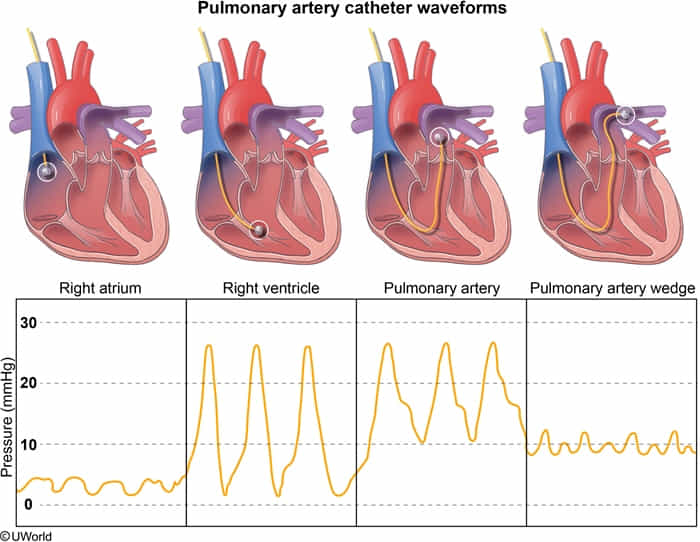
| Location | Pressure (mm Hg) |
|---|---|
| Right atrium | Mean: 1-6 |
| Right ventricle | Systolic: 15-30 Diastolic: 1-6 |
| Pulmonary artery | Systolic: 15-30 Diastolic: 6-12 |
| Left atrial/PCWP/LVEDP | Mean: 6-12 |
Right Heart Catheterization
-
Right Atrium (RA)
- Pressure: Mean 1-5 mmHg.
- Physiology: Reflects central venous pressure (CVP) and right ventricular end-diastolic pressure (RVEDP). It is low because it’s a passive filling chamber receiving deoxygenated blood from the body. The
awave (atrial contraction) is typically more prominent than thevwave (atrial filling).
-
Right Ventricle (RV)
- Pressure: 15-30 / 1-7 mmHg.
- Physiology:
- Systolic (15-30 mmHg): The pressure generated by the RV to pump blood through the low-resistance pulmonary circulation. It must exceed pulmonary artery diastolic pressure to open the pulmonic valve.
- Diastolic (1-7 mmHg): Low pressure during RV relaxation and filling. It is slightly higher than RA pressure due to the ventricle’s thicker wall.
-
Pulmonary Artery (PA)
- Pressure: 15-30 / 4-12 mmHg.
- Physiology:
- Systolic (15-30 mmHg): Nearly identical to RV systolic pressure as the pulmonic valve offers little resistance when open.
- Diastolic (4-12 mmHg): Maintained by the elastic recoil of the pulmonary arteries, continuing to push blood forward into the pulmonary circulation. The dicrotic notch on the pressure tracing indicates pulmonic valve closure.
-
Pulmonary Capillary Wedge Pressure (PCWP)
- Pressure: 6-12 mmHg (no fluctuations because of distal pulmonary arteriole)
- Physiology: Measured by inflating a balloon at the catheter tip, which “wedges” in a small pulmonary artery. This obstructs forward flow from the RV, allowing the catheter to indirectly measure the downstream pressure, which is an estimate of Left Atrial (LA) pressure. PCWP is a key indicator of left ventricular filling pressure (LVEDP).
Left Heart Catheterization
-
Left Atrium (LA)
- Pressure: Mean 6-12 mmHg.
- Physiology: Slightly higher than RA pressure due to the higher pressure system of the left heart. It represents the filling pressure for the LV. The
vwave (atrial filling from pulmonary veins) is often more prominent than theawave.
-
Left Ventricle (LV)
- Pressure: 90-140 / 6-12 mmHg.
- Physiology:
- Systolic (90-140 mmHg): The high pressure required to overcome aortic pressure (afterload) and pump oxygenated blood to the entire systemic circulation.
- Diastolic (LVEDP) (6-12 mmHg): Reflects the pressure in the LV at the end of filling. It is a crucial measure of LV preload and compliance. In the absence of mitral stenosis, LVEDP is approximately equal to mean LA pressure and PCWP.
-
Aorta (Ao)
- Pressure: 90-140 / 60-90 mmHg.
- Physiology:
- Systolic (90-140 mmHg): Nearly identical to LV systolic pressure as the aortic valve offers minimal resistance when open.
- Diastolic (60-90 mmHg): Maintained by the elastic recoil of the aorta and systemic arteries. The dicrotic notch on the pressure tracing signifies aortic valve closure.
Key Physiological Principles
- Pressure Gradients: Blood flows down pressure gradients. For a valve to open, the pressure in the proximal chamber must exceed the pressure in the distal chamber/vessel.
- Systole vs. Diastole: Systolic pressures in the ventricles and great arteries are generated during ventricular contraction. Diastolic pressures are maintained by vascular elastic recoil (in arteries) or represent filling pressures (in atria and ventricles).
- Isovolumetric Contraction/Relaxation: These are periods where valves are closed, and pressure rapidly changes within the ventricles without a change in volume.